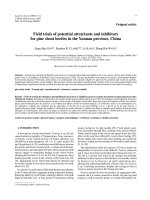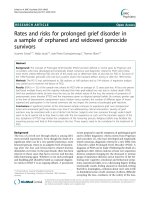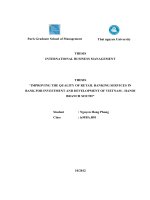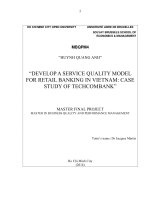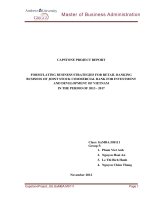LV thạc sỹ_The evaluation and developing for retail banking services in Vietcombank
Bạn đang xem bản rút gọn của tài liệu. Xem và tải ngay bản đầy đủ của tài liệu tại đây (695.93 KB, 92 trang )
i
ACKNOWLEDGEMENT
First, especially I want to express my sincere gratitude to my supervisor, Dr.
…..
May I thank all my classmates and friends for their very constructive
comments, valued ideas and their regular support as well.
Last, but not the least, I thank my families for their support whose
unconditial support is vital for my learning and study success.
ii
TABLE OF CONTENTS
ABBREVIATION..................................................................................................1
LIST OF TABLES.................................................................................................2
LIST OF FIGURES...............................................................................................3
EXECUTIVE SUMMARY...................................................................................4
INTRODUCTION.................................................................................................5
1. Rationale..........................................................................................................5
2. Research objectives..........................................................................................6
3. Research questions...........................................................................................7
4. Research methodology.....................................................................................7
4.1 Research process.........................................................................................7
4.2 Data collection............................................................................................7
4.3 Data analysis...............................................................................................7
5. Scope of research.............................................................................................8
6. Thesis structure................................................................................................9
CHAPTER 1. A COMMON CONCEPT OF WHOLESALE BANKING AND
RETAIL BANKING............................................................................................10
1.1. Wholesale banking of commercial bank.....................................................10
1.1.1. The concept of wholesale banking services..........................................10
1.1.2. Characteristics of wholesale banking services......................................11
1.1.3 The roles of wholesale banking services...............................................12
1.1.4 The services of wholesale banking........................................................13
1.2 Retail banking of commercial bank..........................................................16
1.2.1 The concept of retail banking.................................................................16
1.2.2 Characteristics of retail banking............................................................17
1.2.3 The role of retail banking.......................................................................18
1.2.4 The services of retail banking................................................................19
1.3 Potentials for developing Retail banking..................................................21
1.3.1 Foundations for developing Retail banking...........................................21
1.3.2 Opportunities in Retail Banking............................................................23
1.3.3 Benefits of Retail Banking.....................................................................23
1.4 Expansion from wholesale banking to retail banking...................................25
1.4.1 The bank’s business strategy..................................................................25
iii
1.4.2 Diversification as a mean to achieve bank’s business strategy...............27
1.4.3 Process of product diversification..........................................................28
1.4.4 Evaluation of product diversification.....................................................30
CHAPTER 2. EVALUATION OF SELECTED RETAIL BANKING
SERVICES AT VIETCOMBANK....................................................................32
2.1 Overview of Vietcombank...........................................................................32
2.1.1 Establishment and development.............................................................32
2.1.2 Organizational Structure........................................................................33
2.1.3 Business performance of VCB in period 2008-2010..............................34
2.2 VCB’s current product development in retail banking................................35
2.2.1 Products and services.............................................................................36
2.2.2 Process of developing product...............................................................44
2.2.3 Factors led VCB to retail banking and challenges VCB faced in
developing retail banking................................................................................47
2.3 Evaluation of selected retail banking products at VCB................................51
2.3.1 Selected retail banking products’ performance results...........................51
2.3.2 Evaluation of selected retail banking products.......................................56
2.4 Assessment...................................................................................................63
2.4.1 Achievement..........................................................................................63
2.4.2 Constraints.............................................................................................65
2.4.3 Causes of constraints.............................................................................70
CHAPTER 3: SOLUTIONS TO DEVELOP RETAIL BANKING SERVICES
AT VIETCOMBANK..........................................................................................73
3.1. Strategy of Vietcombank in developing retail banking services..................73
3.1.1. The retail banking development trends.................................................73
3.1.2 Strategy of Vietcombank in developing retail banking..........................74
3.2 Proposed solutions to develop retail banking at Vietcombank.....................77
3.2.1 Build pricing product model..................................................................77
3.2.2 Build internal credit rating system.........................................................78
3.2.3 Build financial model to evaluate the effectiveness of products............79
3.2.4 Build strategy in developing new products and services........................79
3.2.5 Improving banking administration and risk management......................82
3.2.6 Standardize the process of product development at VCB......................84
CONCLUSION....................................................................................................88
REFERENCES....................................................................................................89
iv
1
ABBREVIATION
VCB
SBV
WTO
WB
ATM
POS
BOD
HO
IT
ICT
GDP
FDI
LC
P/E
PIN
Bank for Foreign Trade of Vietnam
State Bank of Vietnam
World Trade Organization
World Bank
Automated Teller Machine
Point of sale
Board of Director
Head Office
Information Technology
Information Technology and Communication
Gross Domestic Product
Foreign Direct Investment
Letter of Credit
Profit on earning
Personal Identification Number
2
LIST OF TABLES
Table 2.1: Financial status of Vietcombank............................................................................35
Table 2.2: Status of individual fund mobilization from 2008-2010................................36
Table 2.3: Status of individual credit 2008-2010..................................................................38
Table 2.4: Status of individual credit by product 2008-2010............................................39
Table 2.5: Status of transfer money through Swift channel 2008-2010........................41
Table 2.6: Status of transfer money through Money Gram channel 2008-2010.........41
Table 2.7: Status of E- banking services 2008-2010............................................................42
Table 2.8: Total amount card issuance.....................................................................................43
Table 2.9: Total oustanding loans and NPL’s rate of Project housing loans 20082010.....................................................................................................................................................53
Table 2.10: Total oustanding loans and NPL’s rate of Car loans 2008-2010..............54
Table 2.11: Total oustanding loans and NPL’s rate of Staff loans 2008-2010............55
Table 2.12: Margin interest analysis of selected retail banking products 2008-2010....60
3
LIST OF FIGURES
Figure 2.1: Model of governance structure of VCB.................................................34
Figure 2.2 : Portfolio of individual credit................................................................40
4
EXECUTIVE SUMMARY
It could be said that the period from 1995 to moment is not a long period in 48
years of Vietcombank’s history but in this period, it witnessed many changes to the
methods and operations in retail banking in a bank that has advantages in wholesale
banking. From a few thousand retail customers in the early 90s, now the number of
individual customers has reached 3 million (over 30% market share in Vietnam) and
continual development of both quantity and quality.
The research objectives of this thesis are to systemize theoretical theories of
retail banking and wholesale banking, potentials for developing retail banking and
expansion from wholesale banking to retail banking and analyze, evaluate selected
retail banking products and realize pending issues of developing retail banking
services at VCB to propose solutions to develop retail banking services at VCB.
The methodology used in the thesis is quantitative analysis. The data of thesis
consists of only secondary data. The secondary information and data will be
obtained from newspaper, annual report, magazine, articles, books…Other
secondary data regarding VCB will be acquired from VCB and other related sources
of information such as SBV, VBA...
From obtained data, the author carried out his own calculation to provide a
better information of the three selected retail banking services of Vietcombank. This
helps to compare the performance of retail banking with wholesale banking services
of Vietcombank.
This research will propose solutions to develop retail banking services at
Vietcombank. The thesis researches all solutions based on strategic orientations of
Vietcombank and the retail banking trends. The solutions were executed base on
studying both theoretical aspect and the assessment reality of developing in retail
banking services.
5
INTRODUCTION
1.
Rationale
In fact, along with the development of economic growth, the big coporations
and enterprises always seek the support and the guarantee in financial capacity
through establishing their own banks. These banks have an absolute advantage in
providing financial services to big corporations which are their traditional
customers and making profits for all the bank system. These banks begin to turn to a
potential retail banking market. In addition, the development of wholesale banking
and retail banking is difficult to separate and becoming mutual factors in the
development of the banks because when the banks supply wholesale banking
products for businesses, they also provide a package of retail banking products to
businesses’ employees.
With 89 million people of population today, Vietnam is clearly a huge market
for retail banking serives. According to a recent report by a consulting firm, Bain &
company, Vietnam banking industry is still in an ealier stage of development at
which by 2007 only 2% of Vietnam’s 84 million people have ever taken out a bank
loan and only 5 million have a personal bank account. Since then it is natural to
expect that these figures have increased but they shall not be significantly
improved. In the past several years, Vietnamese people have witnessed and enjoyed
a greater choice of retail banking services ranging from housing loans, auto loans,
saving loans to bancasurrance, guarantee. To catching the huge and new demand,
general banking and retail banking services in particular in our country is being
developed very rapidly. The bank is constantly launching products, services and
technologies to bring many benefits for customers, boosting turnover in social
capital and promote economic development
Based on the growing trend of retail banking services of commercial banking
system of Vietnam, Bank for Foreign Trade of Vietnam (Vietcombank) has been
implementing most of the banking products and services to customers. A full
awareness of the market importance of retail banking services in the context of
6
international economic integration today, Vietcombank constantly improves the
retail banking products and services, and applies modern technology to develop
retail banking products and services, to meet social needs. One of the activities that
mark the full development, demonstrates the correctness of the above strategy is the
achievement in the areas of retail banking services. Besides wholesale services
which have an international reputation for economic organization (coporate
banking), Vietcombank is known as a trusted address for individual customers with
a variety of services and modern retail banking services as a flexible loan product,
payment cards, ATM system, diversified capital mobilization, the online banking
service, remittance services.
It could be said that the period from 1995 to moment is not a long time in 48
years of Vietcombank’s history but in the period, it witnessed many changes to the
methods and operations in retail banking in a bank that has advantages in wholesale
banking. From a few thousand retail customers in the early 90s, now the number of
individual customers has reached 3 million (over 30% market share in Vietnam) and
continual development of both quantity and quality.
Having recognised the potentials in retail banking and experienced the
difficult conditions by Vietcombank, the evaluation and developing for retail
banking services is chosen as the topic for this MBA thesis. To study mentioned
problems, VCB must push strategies to expand retail banking through using product
diversification as a tool. It is also research purpose of this thesis. The study will
research and offer some lessons and strategies for VCB based on analyzing current
situation and its competence.
2.
Research objectives
Systemize theoretical theories of retail banking and wholesale banking,
potentials for developing retail banking and expansion from wholesale banking to
retail banking.
Analyze and evaluate selected retail banking products and realize pending
issues of developing retail banking services at VCB.
7
Propose solutions to develop retail banking services at VCB.
3.
Research questions
- What is retail banking and how important is it in commercial banks’ operation ?
- Why need to expand from wholesale banking to retail banking ?
- What is the current state of the development in retail banking services at VCB?
- What are solutions to develop retail banking services at VCB ?
4.
4.1
Research methodology
Research process
In this thesis, the research process will follow these stages:
-
Literature review
-
Choose appropriate model to analyze
Collect and analyze data
Findings and recommendations
4.2
Data collection
The data of thesis consists of only secondary data. The secondary information
and data will be obtained from newspaper, annual report, magazine, articles,
books…Other secondary data regarding VCB will be acquired from VCB and other
related sources of information such as SBV, VBA... From obtained data, the author
carried out his own calculation to provide a better information of the three selected
retail banking services of Vietcombank. This helps to compare the performance of
retail banking with wholesale banking services of Vietcombank.
4.3
Data analysis
The methodology used in the thesis is quantitative analysis. And in this study,
a simple model will be applied:
Lending interest rate = Fund mobilization interest rate + Operating expenses
rate + Risk premium rate + Gaining profit rate
Where:
+ Lending interest rates is the lending interest rate which applied for each
retail product;
+ Fund mobilization interest rate is the fixed deposit interest rate with term
12 months;
8
+ Operating expenses rate is calculated by dividing the operating expenses
(include: the salary, rent house, depreciation, materials…) to everage
+
individual outstanding loans.
Risk premium rate is based on budget risk expense divide everage
individual outstanding loans ;
+ Gaining profit rate is calculated by formula: Gaining profit rate =
Interest margin – Operating expenses rate - Risk premium rate.
In Vietcombank, Lending interest rate = Fund mobilization interest rate +
Interest margin. So that Interest margin must cover all the components: Operating
expenses rate, Risk premium rate, Gaining profit rate and also ensure the
competitive lending interest rates in the market. Based on the data conducted by
VCB’s report from 2008-2010, I will employ the model above to analyze the effect
of product development on cost and profit efficiency.
5.
Scope of research
The study was conducted at Vietcombank only as follows:
- Time: The time research is a period from 2008- 2010.
- Products: The research focuses on some current retail products at
Vietcombank like: auto loans, housing project loans, staff loans.
- Geographic scope: The primary data would be collected in the whole system
at Vietcombank
Limitations: This research focuses mainly on financial aspects of evaluation of
selected retail banking services at Vietcombank and the data were 2008-2010. It
also gave out solutions to develop retail banking services at Vietcombank only, not
for the whole economy and other banks. Limitations of the thesis also lie on its sole
research on the developing retail banking services, instead of comparing working
model on developing retail banking services at Vietcombank to those of other banks
who have succeeded in this field. So this search is for Vietcombank, if it were
applied for another, we should take further and supplemental study.
6.
Thesis structure
This thesis is divided into 3 chapters as below:
Chapter 1: A common concept of wholesale banking and retail banking
9
This chapter discusses on theories about retail banking and wholesale
banking, potentials for developing retail banking and the expansion from wholesale
banking to retail banking.
Chapter 2: Evaluation of selected retail banking services at VCB
This chapter will outline overview of Vietcombank’s business result and it also
accesses the development of retail banking services at Vietcombank. These
assessment will supply all achievements, constraints and causes of constraints of
development in retail banking services.
Chapter 3: Solutions to develop retail banking services at VCB
This chapter will propose solutions to further develop retail banking services
at Vietcombank. The chapter researches all solutions based on strategic orientations
of Vietcombank and the retail banking trends. The solutions were executed base on
studying both theoretical aspect and the assessment reality of developing in retail
banking services.
10
CHAPTER 1. A COMMON CONCEPT OF WHOLESALE
BANKING AND RETAIL BANKING
1.1. Wholesale banking of commercial bank
1.1.1. The concept of wholesale banking services
The concept of wholesale banking was first used in the late '60s of the 20th
century in England (David Cox, Shelagh Hefernan in England, George H. Hempel,
Linda Allen in the U.S.). Because the formation and development of wholesale
capital markets, then the banks begin to participate in this market and make loans
with money from depositors. Wholesale banking is the term used for transactions
between banks and large customers (companies) or dealing with large amounts (up
to deposit and lending hundreds of thousands to millions of dollars or pounds). This
term also refers to the wholesale’s transactions between banks made through interbank market which separate from clients. Wholesale banking’s activities embeded
with the development of wholesale market, and then the development of multinational banks and applied flexibly in international finance activities.
Depending on the financial conditions in each countries, there are different
definitions of wholesale banking such as:
- In the U.S, wholesale banking services is the bank’s services between
commercial banks (Merchant Bank) and other financial institutions. In particular,
Merchant Bank is defined as a business major bank which provide the international
trade finance, long-term loans to companies and issuance guarantee. Merchant Bank
does not offer banking services to individual customers.
- According www.saga.vn, wholesale banking services is providing complete
financial statements to enterpises and banking services to other institutional clients
such as pension funds as well as government agencies. These services include
lending, cash management, commercial mortgages, working capital loans, leasing,
mandate services, ... Most of banks divide wholesale banking activities into
11
different services varied by enterprises size like: big enterprises, small and medium
enterprises.
In summary, combining the above definitions, we have the concept of
wholesale banking servcies as follows: “Wholesale banking services is the
provision of services by banks to the clients such as large corporate clients, midsized companies, real estate developers and investors, international trade finance
businesses, institutional customers (such as pension funds and government
entities/agencies), and services offered to other banks or other financial
institutions. In essence, wholesale banking services usually involve high value
transactions”.
1.1.2. Characteristics of wholesale banking services
Banking is an industry of economic service sector in the international
economy, and is a division of financial services in general, such as public finance
services and operation services on financial market, thus wholesale banking also has
common features of economic services such as:
- The number of customers is small: The targets of wholesale banking are
mainly large-scale enterprises so the number of customers are not much. Normally,
with a wholesale and retail banking, the number of wholesale’s customer accounts
from 10% to 30% of customers.
- Big value transactions and the average cost per transactions is small.
- Services and implementation processes are often complex, take a lot of time.
For example, to lend a big business, banks often have evaluated the projects longer
than a personal loan.
- The revenue from the customers are enormous: With about 10% of
customers can bring 50% of income for the banks. Therefore, the business risk of
wholesale banking is very high when customers come to other banks with better
conditions.
12
- The average of operating costs is low: Wholesale banking often does not
require much equipment in distribution network and human resources as the number
of customers in wholesale banking is less than retail banking.
1.1.3 The roles of wholesale banking services
For the economy
Through the wholesale’s lending, the banks provide a large amount of capital
for businesses to meet the goals of economic- social development. Especially, in the
current integration, wholesale’s services have a big role with the growth of the
economy. Besides, the payment through bank with large transaction value reduces
the cost of using cash, saves social costs. In addition, wholesale’s services also
create favorable conditions for the development of other bank’s services, to help
banks diversify business activities, reduce risk, thereby create a stable, sustainable
finance for the country.
For commercial banks
If the retail banking decides the scale of funding mobilization, the wholesale
banking decides the scale of lending. For banks, the credit is specific and primary in
the creation of profit. Profit is the basic for the survival and growth of commercial
banks.
With a intermediary payment function, wholesale banking make the payment
on a large scale regualarly, so that the banks also collect a lot of service fees. In
addition, it also facilitates the other banks’ services development easier. For
example, the salary payment for the employees is developed by opening deposit
accounts of the company in banks. Besides, due to the number of customers is less
but it occupies a large proportion of sales transactions so the banks can save
transaction cost based on advantages of the size of transaction.
For customers
Through the provision of credit, wholesale banking plays an important
channels for injecting capital firms to carry out investment projects or import and
export goods while self-funding becomes droughty. This is one of the key factors to
13
determine the success of the business plan and profitability of the company. The
quick and schedule disbursement will help businesses save a lot of time and costs,
improve efficiency of their capital, thus contributing to profit growth.
Besides, by the funding mobilization services from businesses, the banks help
them store, manage and balance money effectively. Wholesale banking is also
intermediate payments to the company due to the quick, convenient, safe payment
instrument, help to promote the cash flow and the reproduction of companies.
With the customers are banks, through the mobilization of capital between
banks, the electronic payment services also has the opportunity to develop through
the application of modern payment instruments, reducing the risk and high
economic efficiency.
1.1.4 The services of wholesale banking
Mobilization capital
Commercial banks can mobilize capital from banks and large companies in
many varity of products, including current account, term deposits, issuing valuable
papers … Two kind of mobilization capital that banks often offer to their customers
inlcudes:
- Current accounts: of the wholesale’s customers often have very big balance
of payment because there are a lot the needs of business transactions and inter-bank
payments between banks. Customers who choose this type of deposit often have the
purpose of ensuring safety and utilities in payment transactions through the bank.
- Term deposit: is a significant sources of mobilization capital from big
enterprises and credit instituations. However, because of the regular demands in
transactions, customers only deposit in short term
In addition, commercial banks could raise capital from other sources such as
deposit, deposit to guarantee payment, the other deposits ... or issuing valuable
papers such as promissory notes, certificates of deposits, saving certificates and
bonds.
Credit
14
This is typical and most important activity in wholesale banking. The kind of
credit includes:
- Loan: this is a kind of credit which has the highest proportion and is popular
credit service of commercial bank. Basing on loan term, loan includes two types:
short-term loan (to invest in liquid assets), medium- long term (to invest in fixed
assets, implement project to develop production and business). In the kind of loan,
project finance and co- finance are typical loans and accupied a high outstanding
loan rate.
+
Project finance: This type of loan to help accelerate investment in
infrastructure and production in Vietnam.
+ Co-finance: is the process of providing credit with the participation of two
or more financial institutions and one financial institution is a clue in financing for
all or a part of projects.
- Discount: the banks can discount commercial papers and other short-term
valuable papers for big enterprises and can re-discount them to other banks. With
this service, the banks help enterprises recover capacity payments and accelerate
capital flows.
- Guarantee: is the commitment of banks, which is made on a document to
commit to the beneficiary. If at maturity, the obligor does not perform the
commitments stated in the contract, the bank will be on behalf of the guarantor to
implement the commitments.
- Financial leasing: is a transaction between two entities, including the owner
and the user of property, in which the owner (lessor) transfers property to the lessee
use in a given period and the lessee must pay money for the owner.
- Factoring: this is a kind of providing credit to the seller through the
acquisition of receipts arised from the sale of goods which is agreed upon in the sale
contract.
Payment services
15
- Domestic payment: includes payments between enterprises and payments
between banks. Payments between enterprises through banks is extracting money
from the account to pay into other account of beneficiaries through the
professionally accounting of banks. There are a lot of methods of payment through
the banking system, such as payment by authorized payment, collection, transfer
automatically or periodically...
- International payment: this service is often applied for the import-export
companies as payment for goods between the seller or the buyer. The international
payment transactions are usually done through primary methods such as letter of
credit (L / C), collection, transfer money.
Trading foreign currency
- Dealing foreign currency in the inter-bank foreign exchange market: is a
kind of trading foreign currency between commercial banks through inter-bank
market
- Foreign Exchange with enteprises: Exporting enterprises often have demand
to sell foreign currency which received by exporting to take VND or other
currencies. Besides, they also need to buy and sell foreign currency following
forward contracts or option contracts to hedge exchange rate risk. Meanwhile,
importing enterprises often need to buy foreign currency for payment of mature
import contract and purchasing foreign currency by forward or option contracts to
hedge exchange rate risk.
Treasury services
- Collection and payment at counter: The banks receive money from
customers who have demand on savings, deposit money in current account,
repaying loans, transfer money, foreign exchange ... Besides, the banks also pay
money for customers who have demand to withdraw money from savings, current
account, loan account.
- Collection and payment by banks: The banks are on behalf of customers to
collect money from buyers, pay salary, pay for customers’ partners.
16
E- banking services
E- banking services is a combination between the banks with internet
activities. E- banking services for wholesale banking‘s customers are mainly Home
banking and Internet banking. The customers of E-banking services are mainly
banks, enterprises, organizations which aimed to use consultant services and seek
information.
Other services
In addition to the above services, wholesale banking also provides other
services such as box services, mandate services,..
1.2
Retail banking of commercial bank
1.2.1 The concept of retail banking
“Retail banking is typical mass-market banking where individual customers
use local branches of larger commercial banks. Services offered include: savings
and checking accounts, mortgages, personal loans, debit cards, credit cards, and
so”
Retail banking means mobilizing deposit form individuals and providing loan
facilities to them in the form of home loans, auto loans, credit cards, etc, is
becoming popular. This used to be considered by the banks as a tough proposition
because of the volume of operations involved. But during the last couple of years or
so, banks seem to have realized that the only sustainable way to increase deposits is
to look at small and middle class consumer retail deposit and not the price sensitive
corporate depositors.
With annual income of population is growing every year. The banks are trying
to seize this market through a series of innovative additions to their products,
services, technology and marketing methods. Fixed and unfixed Deposits, (cluster
deposits which can be broken into smaller units to help meet depositors’ overdraft
without breaking up entirely), centralised database for any branch (whereby the
customers can access their account in any branches where the account is
maintained), room services (whereby the customers are visited at their residences
17
offices to enable them to open their accounts), automatic teller machines, tele
banking network, extended banking time, courier pickup for cheques and
documents, etc are some of the privileges extended to the customers by the banks in
are eagerness to cultivate the retail market. In short, in the bold new world of retail
banking, the customers are like king.
1.2.2 Characteristics of retail banking
The features of retail banking also are common features of economic services,
so in those characteristics, we can summay through the following contents:
- The target customers of retail banking are enormous: individuals,
households and SMEs with a big of numbers and variety kinds of services.
- The number of products and services is diversified, but the value of
individual transactions is not high. Products of retail banking include the products
of liabilities (funding), assets (loans) and other products which diversified in variety
and rich in form. However, the number customer of retail banking is big, so to serve
each customer of retail banking, the banks must also spend the same cost as a
wholesale ‘s customer so the average cost per transaction of retail banking is often
big.
- Retail banking services developed primarily based on technology and
human resources. The development of retail banking services depends on the level
of development of information technology in the economy and in each bank.
Typically, E- banking services are applied modern technology to expand and
improve the quality of products. In addition, to provide products and services to
individual customers, retail banking needs a great number of staffs and professional
expertises.
- Simple services, easy to implement: Retail banking’s goal is individual
customers, so it focuses on products and services such as deposit accounts, loans,
credit card ...
18
- The average of operating cost is high: The number of customers is crowded
but spread everywhere so the transaction is not convenient. Thus, to serve these
customers, banks often have to expand and invest on online trading with high cost.
- Management methods and the form of marketing in retail banking is more
complex than wholesale banking by the network client is widespread.
1.2.3 The role of retail banking
For the economy
Retail banking services contribute to exploit the resources of the economy and
contribute to the implementation of national monetary policy. This role is expressed
through facilitating the cash flow, take advantage of the tremendous potential of
capital from individuals, SMEs to develop the economy, improve people's life, limit
the using cash in payment, save cost and time for both banks and customers.
The more developmet retail banking services are, the more specialization the
banks provide products and services to customers, bring services closelier to users,
reduce social costs and improving business efficiency of other subjects.
The development of retail banking services based on advanced and modern
technology, present civilization of the national economy because it alters directly
the economy from cash payment to non – cash payment economy . By using noncash payment, retail banking services improve the efficiency of State management
in currency, control commercial frauds, tax evasion and corruption.
For banks
Today, if any bank hold the opportunity to expand retail banking services for a
huge population that are short of financial services in the emerging economy, they
will become global giants in the future. Thus, retail banking services has an
important position in the activities of commercial banks in the world, the global
retail banks will play a key role in the list of top 20 global banks ranked by The
Banker magazine in 2015. The Vietnamese Commercial Banks have been
developing retail banking services because this is an inevitable trend, consistent
with the general trend of the banks in the region and in the world, ensure for the
19
banks manage the risk effectively, supply the high quality services to customers,
orient business, objective market, to help the banks achieve optimal business
performance.
In the financial perspective and bank management, retail banking brings
revenue stability, certainty, reduce risk by outside factors because this is an area that
less affect by economic cycles. Revenues will increase if the banks attract more
customers to use their services. Developing retail banking services is the most
effective way to change the structure of the bank’s income. With complex market
conditions, credit activity becomes riskier, so if the bank only depends on the
revenue from credit interest, it will be uncertain. Thus, developing retail banking
services will increase revenue for banks.
Retail banking services plays a key role in expanding markets, improving
competitiveness, creating medium and long term capital for the banks, diversifying
the banks’ activities... Retail banking expands cross-sold between individuals and
businesses with banks, thereby it increases network and develops the existing
customers and potential of commercial banks.
Developing retail banking services will bring many benefits from raising
capital, credit and services to commercial banks. Beside relatively stable period
capital, commercial banks can use the balance of current accounts, issuing card
accounts, deposit accounts ... to raise funds with low interest rates.
For Customers
Because this sector has advantage in scale and scope so as the more people
join in, the lower cost and more convenient the users. The development of retail
banking services based on advanced technology to save manpower and reduce
operating costs, thereby it reduces the cost of services for customers. Customers
will get the better services because retail banking brings to customers the
convenience, safety, savings in payment process and using their income.
20
Especially for SMEs, through capital funding and other utility of billing, retail
banking facilitate business and production process smoothly, rhythmically,
contribute to accelerate the production and circulation of goods.
1.2.4 The services of retail banking
Capital mobilization
The banks raise funds from individuals and SMEs mainly in the form such as
cash deposits, term deposits, savings deposits, issuance of valuable papers.. In the
form of retail mobilization, savings occupies a big part of banks’ capital, create a
long-term capital to finance the credit activities of banks. In the worldwide, there
are two main types of savings:
- Unmature Savings: when the senders want to withdraw money, they must
notice to the banks before a period of time. But today, the banks often allow
customers to withdraw money without notice.
- Purpose - Savings: senders deposit in banks to use for a specific purpose
such as buy houses, pay study cost. With these customers, banks often provide
credit to compensate deficiency when they use follow the purposes of savings.
Credit
Retail banking provides loans to individuals (such as studying oversea loan,
installment loan, car loan, housing loan, investment securities, trade gold, buy real
estate…) and loans to households and SMEs (such as busniness loan, overdraft,
limit loan). In the credit industry, commercial banks are always active and dominant
in providing credit to individual customers. In general, now the commercial banks
have developed diversified and rich credit products for individual customers. Now
the banks often focus on key group loans such as salary payment loan, consumption
loan, study oversea loan, auto loan, traveling loan, housing loan, installment loan...
About regulations and procedures, individual lending is continue to comply
following the credit regulations of financial institutions.
Overall, the proportion of loans to SMEs and individuals is growing in total
outstanding loans of banks, and it contributes to increase turnover and profits for the
21
banks. However, individual loans often have high management costs because the
value of loans is often small and dispersible. In addition, the borrowers are often
sensitive with factors such as interest rate, term and procedures so the banks are
affected by competitive factors in the market and self- interest of customers.
Payment services
On behalf of clients, the banks make payments for purchasing of goods and
services such as issuing and balance check, provide electronic payment network...
They implement these services by opening current accounts for customers. The
common services of payment include checks, payment cards, collection, order for
payment, commercial paper. With the provision of non-cash payment services,
banks bring to individuals and SMEs a lot of utilities in payment. With these
services, banks can increase their income from fees and develop other services.
E- banking ervices
In recent years, with the development of information technology, banks have
developed a lot of modern services, brought utilities for customers and satisfied the
demands of customers.
With these modern services (such as phone banking,
internet banking, mobile banking, home banking), customers can check account
balances; check recent transactions; seek information about exchange rate, interest
rate, products and services of the banks; access information on individual accounts,
make transactions at home or office via your computer connected internet...
Other services
In addition to the above services, services for SMEs include international
payment services, foreign exchange, guarantee. Services for individuals include
remittance services, collecting / order to payment, transfer money, and safe box.
1.3
Potentials for developing Retail banking
1.3.1 Foundations for developing Retail banking
Globalization process along with new opportunities and new risks is one of
the factors which promote the issuing new products.



